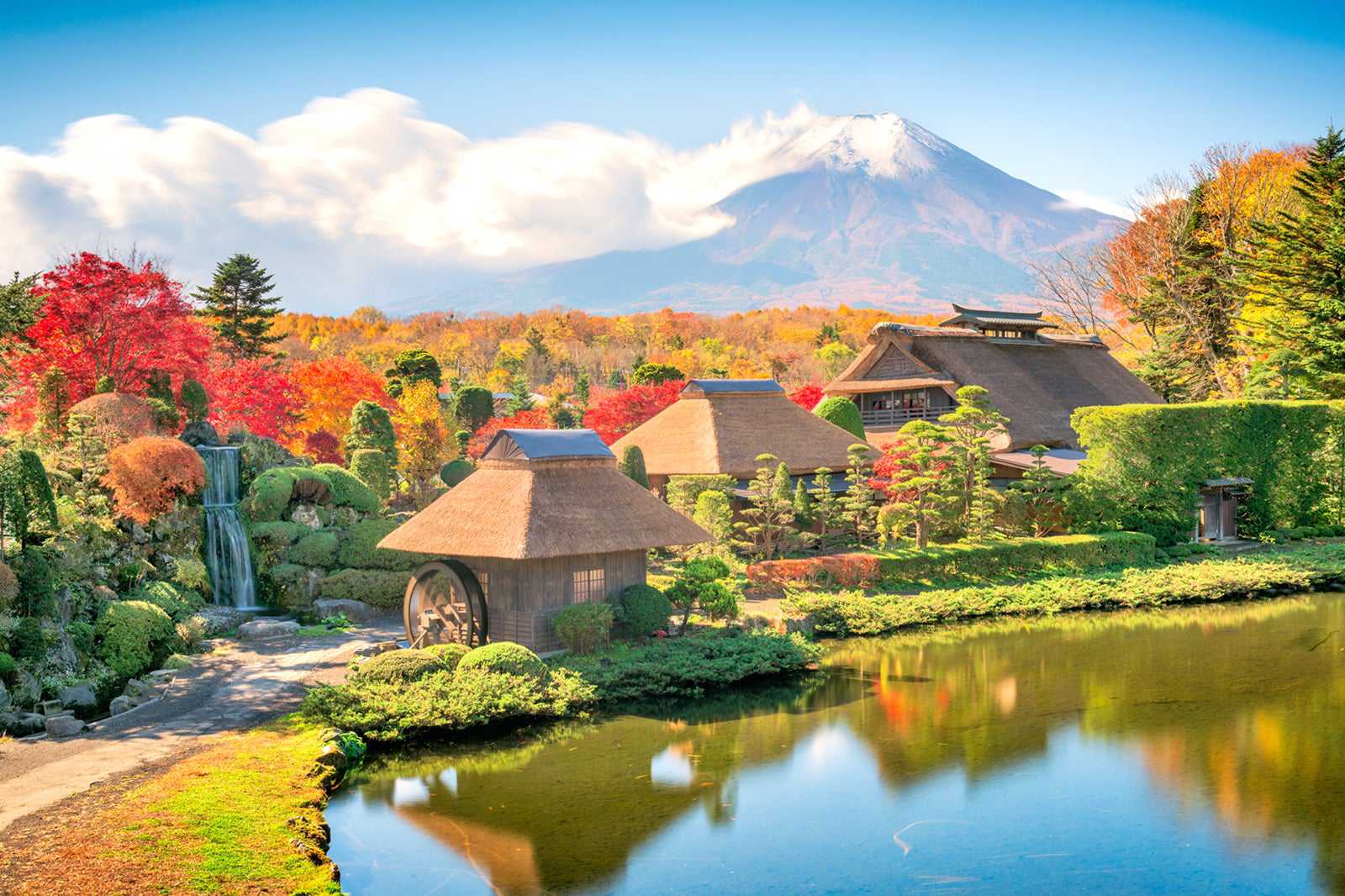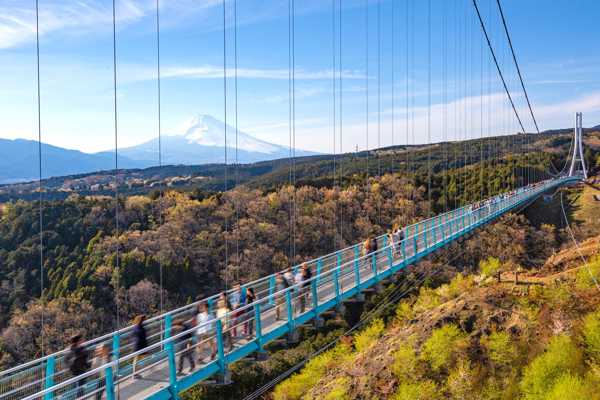Our Fujinomiya Travel Essentials will help you plan the ultimate holiday to this iconic city located at the foot of majestic Mount Fuji. We'll offer valuable insight into the local climate and information including emergency phone numbers, currency, plug styles and everything else you need to know to have a comfortable and fulfilling adventure. This guide will even help get you in and around the city.
While the views in Fujinomiya are certainly impressive, the most notable attractions and festivals can make your holiday truly stand out, and we're happy to highlight some of the best available. This guide is the key to exploring Fujinomiya and the legendary Mount Fuji.
When is the best time to travel to Fujinomiya?

- Temperatures vary greatly in Fujinomiya based on the season, with average summer temperatures around 23°C and average winter temperatures around freezing with a few degrees of variance.
- Fujinomiya has a fairly defined rainy season, with June having an average 33% chance of rain daily, though the most total rainfall typically occurs in September, with average precipitation of 28.2 centimetres.
- The warmest months are August and July, reaching highs of 28.4°C and 27.4°C respectively on average.
- The best time to visit Fujinomiya is spring when the temperature is comfortable and rain isn't all that much of a problem, though it can get pretty crowded. Winter is ideal if you're trying to avoid rain and crowds, but it can be quite cold.
Fujinomiya basics

- Plug type: Fujinomiya uses Type A and Type B plugs like the rest of Japan and what you'd find in North America, so Type G plugs will need an adapter.
- Electricity: The standard voltage is 100 V with a standard frequency of 50/60 Hz.
- Currency: Fujinomiya uses the Japanese yen.
- International dialling code: The international dialling code for Japan is +81.
- Emergency telephone number: Japan's emergency phone numbers include 110 for police and 119 for fire and ambulance services.
Ezek is érdekelhetnek
- 10 Best Spas in Fujinomiya

10 Best Spas in Fujinomiya
Japan - 10 Best Local Restaurants in Fujinomiya

10 Best Local Restaurants in Fujinomiya
Japan - 8 Best Things to Do After Dinner in Fujinomiya

8 Best Things to Do After Dinner in Fujinomiya
Japan
How to get to my hotel in Fujinomiya?

Several options are available to get you into Fujinomiya, so arriving won't be too much of a journey. The closest airport to Fujinomiya isn't international, but Narita International Airport is still fairly close, as is Haneda Airport. Both of these options allow you to take the train straight to Fujinomiya from the airport. From there, taxis, buses and local rail can get you well within walking distance of your hotel.
Airports
The closest airport to Fujinomiya is Mt. Fuji Shizuoka Airport, which is about an hour's drive from Fujinomiya's city centre. This airport only takes domestic flights, however, so it's an ideal choice if you're already in a place like Sapporo, Okinawa or Kyushu. The closest international airport is Haneda Airport, which is about halfway between Tokyo and Yokohama a little over an hour east of Fujinomiya.
Major train stations
Taking the train into Fujinomiya is easy, especially if you land near Tokyo. The Tokaido Shinkansen bullet train has a stop at the Mishima station. From there, you can transfer to Fuji Station, then take the JR Minobu Line straight to Fujinomiya Station, which will be the one closest to your Fujinomiya hotel.
Ports
Fujinomiya is a few miles inland, so there aren't any ports in the city you can use to enter.
How to get around Fujinomiya?

Travel tips
Most of your travel around Fujinomiya will likely be by bus or taxi. The bus network can take you all around town as well as around the entirety of Mount Fuji. Some of the buses can even get you fairly close to the summit and put you at the foot of popular hiking trails. The Mt. Fuji West Side Story Passport is particularly useful for travellers looking to take in all the sights of the mountain for a discounted price, as it allows unlimited use of buses on the west and north side of the mountain for 2 days.
Underground system
There is no underground system in Fujinomiya, and even local rail is limited to the Minobu Line that passes through Fujinomiya Station. The train is useful for getting in and out of town, but the town itself is often traversed by other means.
Taxi and rideshare apps
Taxis are especially popular throughout Fujinomiya, with some specialising in giving travellers rides up the mountain near the summit to begin a hiking trail. Of course, taxis are readily available for other routes, too. Rideshare apps are available as well including popular options like Uber.
Bus network
The bus network around Fujinomiya is particularly comprehensive, as it can get you all around the city in addition to Fuji Five Lakes and Shiraito Falls. Buses can take you directly to Fujinomiya 5th Station, which is popular during the hiking season. On the west and north side of the mountain, the Mt. Fuji West Side Story Passport makes it easy to ride the bus and get discounts at certain attractions along the way. Passes can be purchased at Fujinomiya Station.
Car hire
Driving yourself around Fujinomiya is an efficient way to travel given the quality of roads and available parking in the area. Car hire is easy to come by as well. All you need to get one is to have an international driver's licence acquired in your home country and be at least 18 years of age. The roads and parking in the area extend as far as popular hiking trails on the mountain, so you really can travel virtually anywhere by car.
Bike hire
Bike hire is common in Fujinomiya for more adventurous travellers, thanks to the bike paths available around the mountain. Some can be fairly challenging, like the Fujinomiya Line, so make sure you're ready before trying any of these paths.
What are the main annual events in Fujinomiya?

Yabusame Matsuri
- When: May
- What: Yabusame Matsuri is a horseback archery festival that allows attendees to see impressive feats performed by master archers while riding at high speed on horseback. It's a long-standing traditional festival dating back to 1193 when Minamoto no Yoritomo dedicated it to the local shrine.
- Where: Sengen Grand Shrine
Gojinka Matsuri
- When: 1st Saturday of August
- What: Gojinka Matsuri is a fire festival that features parades and dancing throughout the city. The mikoshi float features the sacred Gojinka fire that stays lit throughout the parade as it travels through the streets of the city and eventually up the Kanda River. Traditional folk dancing takes place too, including the iconic Gojinka-ondo.
- Where: Throughout Fujinomiya City and Shizuoka
Fujinomiya Autumn Festival
- When: November
- What: The Fujinomiya Autumn Festival is an annual festival that began as a peace-seeking event for the mountain, and it continues that role today with traditional performances of singing and dancing. Parades are held along with traditional ballad performances. Plenty of street food is offered from hawkers as well, so you never have to go far for a tasty snack exclusive to the festival.
- Where: Fuji Palace
What are the main landmarks in Fujinomiya?

Fujisan Hongū Sengen Taisha
Fujisan Hongū Sengen Taisha is an iconic shrine dedicated to Mount Fuji that's home to impressive Sengen-style buildings and tranquil ponds. The water in the pond is fed by snowmelt from the mountain filtered through volcanic rock, so it's remarkably clear. This shrine is also considered the starting point for climbs to Mount Fuji.
Oshino Hakkai
Oshino Hakkai is an area of 8 iconic ponds with clear, fresh spring water you can drink right from the source in several places. The area in general is calm and tranquil, with traditional-style buildings and local plants and fish in many of the ponds. The Hannoki Bayashi Shiryokan is also located here and features an open-air museum displaying old farming tools and household items of times past.
Mt. Fuji World Heritage Centre
The Mt. Fuji World Heritage Centre is a museum dedicated to the mountain that offers fascinating insight into the volcano's seismology and effect on local history and culture. The building features an upside-down conical design to make it look like the mountain when viewed in the pond's reflection outside.
Chureito Pagoda
Chureito Pagoda is a 5-storey pagoda overlooking the city that's part of the Arakura Sengen Shrine. The massive pagoda offers picturesque views of the city and Mount Fuji in the distance, and it's especially alluring during cherry blossom season or in the fall when rich, vibrant colours bloom from the surrounding flora.
Ez a cikk a Go Guides szerkesztőségének véleményét ismerteti. A Hotels.com ellentételezést nyújt a szerzőknek az ezen a weboldalon megjelenő írásaikért; az ilyen ellentételezések körébe tartozhat az utazási és egyéb költségek megtérítése.
Kezdj hozzá az utad tervezéséhez!
Hol érdemes megszállni Fujinomiya területén

Dormy Inn Express Gotemba Hot Springs

Hotel Clad

Mars Garden Wood Gotemba

Fujinomiya Fujikyu Hotel

FUJI OUTLET HOT SPRING HOTEL

Toyoko Inn Gotemba Ekimae

Tabist Yuen no yado Fujimi

Dormy Inn Mishima Natural Hot Spring

Hotel KAN-RAKU Fujisan Gotemba

Daiwa Roynet Hotel Numazu
Kapcsolódó bejegyzések
- 10 Best Spas in Fujinomiya

10 Best Spas in Fujinomiya
Japan - 10 Best Local Restaurants in Fujinomiya

10 Best Local Restaurants in Fujinomiya
Japan - 8 Best Things to Do After Dinner in Fujinomiya

8 Best Things to Do After Dinner in Fujinomiya
Japan - 10 Best Family Things to Do in Fujinomiya

10 Best Family Things to Do in Fujinomiya
Japan - 10 Things to Do in Fujinomiya on a Small Budget

10 Things to Do in Fujinomiya on a Small Budget
Japan - 9 Great Restaurants in Fujinomiya

9 Great Restaurants in Fujinomiya
Japan - 9 Best Things to Do in Fujinomiya

9 Best Things to Do in Fujinomiya
Japan - 10 Best Things to Do in Fujinomiya

10 Best Things to Do in Fujinomiya
Japan
